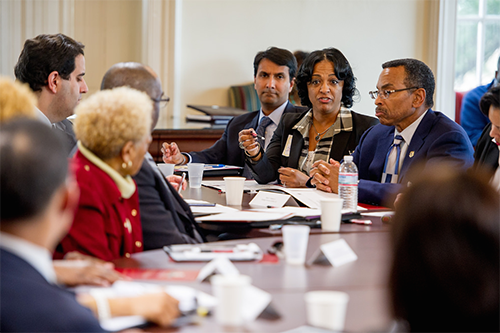Apr 01 2015 First things first: Advice for engaging collaboration partners
 An estimated 40 percent of carbon dioxide pollution in the United States comes from energy used in homes. In Portland, Oregon, the Bureau of Planning and Sustainability wanted to provide homeowners an affordable opportunity to retrofit their homes with energy efficient upgrades, while also addressing issues of employment equity among residents and minority-owned businesses — an initiative that would require intersector collaboration across government, business, and non-profit sectors. But where to begin?
An estimated 40 percent of carbon dioxide pollution in the United States comes from energy used in homes. In Portland, Oregon, the Bureau of Planning and Sustainability wanted to provide homeowners an affordable opportunity to retrofit their homes with energy efficient upgrades, while also addressing issues of employment equity among residents and minority-owned businesses — an initiative that would require intersector collaboration across government, business, and non-profit sectors. But where to begin?
Engage Potential Partners
As a first step in cross-sector collaborations, before undertaking key diagnosis decisions such as Share a Vision of Success or Account for Resources, leaders should seek to identify and engage individuals and organizations that have a stake in the issue at hand to assess their suitability for and interest in a cross-sector partnership.
Selecting appropriate partners is crucial to ensuring that the collaboration has adequate influence and resources to meet its goals. Rather than proceeding alone or with a set of “usual” or “obvious” partners, stakeholder mapping and engagement allows potential collaborators to learn about existing networks and efforts that are tackling the same issue, as well as those (often overlooked networks and efforts) that may be impacted by partners’ efforts. This process also encourages alignment of potential partners’ interests and resources to more effectively reach the desired outcomes.
Leaders are best equipped to select suitable partners when they have a comprehensive understanding of the individuals and organizations – working in isolation or together – that are addressing issues related to the problem the collaboration aims to solve. If leaders overlook important potential partners, they may encounter external resistance to their efforts during implementation or find it hard to achieve impact at the desired scale because of a lack of support or buy-in from key stakeholders.
To avoid these pitfalls, leaders can review publicly available information such as annual reports and websites to gauge potential partners’ capacity to disseminate information; relationships with funders, government officials, or community groups; and memberships in coalitions or associations that could be leveraged in service of the collaboration’s goals. Those hoping to partner with others may also develop a network map to trace the degree of financial and nonfinancial influence a potential partner may have, as well as the strength of relationships between actors, organizations, and institutions within a network. Lastly, individuals may arrange for exploratory conversations with potential partners to gauge interest in collaborating across sectors and to convey the benefits of sharing ownership of a solution to a complex problem.
In the case of Portland, government, business, and non-profit partners came together to create Clean Energy Works Portland (CEWP), an innovative pilot program designed to provide energy upgrades to 500 Portland homes and cut energy consumption by 10 to 30 percent using an innovative financing model to eliminate steep upfront costs. The initiative began when, in 2009, the City of Portland convened nearly 50 diverse stakeholders over a series of meetings to collaboratively draft a proposal for the CEWP financing structure, which Mayor Sam Adams ultimately presented to the City Council. The meetings included a cross section of individuals from a myriad of organizations and businesses that had a stake in the program’s proposed outcomes: private utility companies, the energy sector, workers’ unions, minority-focused apprenticeship programs, associations of minority contractors, and policy program designers. Facilitated by a mediator, stakeholders also developed a Community Workforce Agreement, which now serves as the City’s equity template that promotes better hiring standards to support marginalized communities.
A first in the nation and a model for private-sector funded energy upgrades, the CEWP pilot facilitated 584 loans for whole home energy retrofits, resulting in a 20 percent or greater reduction of energy consumption in homes. Employment equity commitments provided employment for more than 400 workers, with their average wages surpassing $20/hour. Half of the hours worked were by minorities, while more than 20 percent of participating construction firms were operated by minority business owners.
Read The Intersector Project Case Study “Retrofitting Homes for Energy Efficiency in Portland.”
